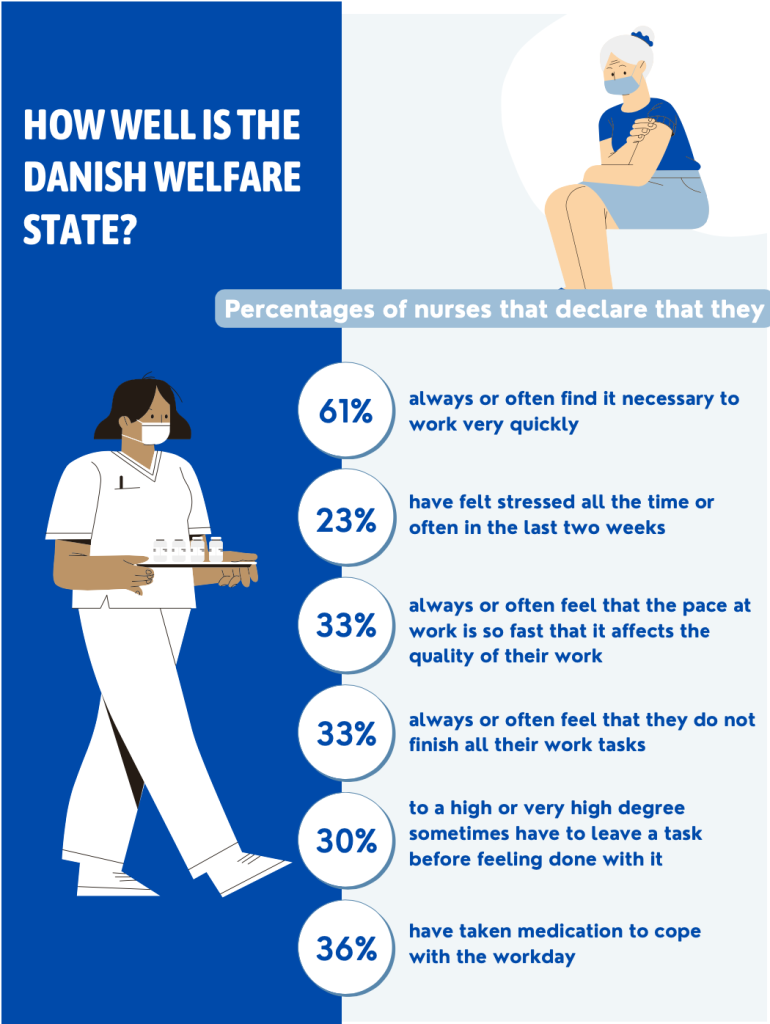The Danish healthcare system has a remarkable reputation all over the world of being one of the best. Short waiting times, well-functioning hospitals and competent staff – all of that provided to Danish citizens free of charge. But reputation does not always reflect truth. In recent years, Danish healthcare has seen a concerning shift in patterns. One of the reasons being that there is a lack of nurses.

By: Anna Sofie Grebe Østergaard and Sara Schwartz Wiman
A big, brown building block with countless windows towers over northern Copenhagen. Perhaps not a piece of the fine architecture that the city is known for, yet it is still one of the most important buildings in the entire country of Denmark. It’s Rigshospitalet, Denmark’s national hospital. Yearly, more than 350 000 patients are treated here, by over 12 000 employees.
One of Rigshospitalet’s employees is Pernille. She is a nurse for two years, and is currently working at the heart-and-lung department. The reason for her choosing the path to become a nurse was simple, she knew she would find a job easily after graduation.
“It was a safety for me to know that I actually would be able to use my education for something,” she says. “When I was done in school I could start working as a nurse straight away.”
Lack of nurses is a big problem
Pernille is right about not having to worry to find a job. Denmark is currently experiencing a lack of nurses. 45% of all attempts to recruit a nurse failed in the period of December 2021 to May 2022, compared to only seven recruitment attempts failures before the outbreak of covid-19.
The lack of nurses has one major reason, and one major consequence, which will be explained further down. The reason is that Danish nurses for a long time have been urging for better working conditions and higher salaries. A large strike occurred in 2021, going on for almost ten weeks. The participating nurses striked for higher pay, a requirement that was not met in the end.
Pernille did not participate in the nurses’ strike, but has her own share of experience of working under stressful and grueling conditions.
“In general, the whole process of being trained in new functions has accelerated in order to be able to cover different tasks as well as possible so that you can handle a lot of different jobs. And that has put enormous pressure and has been extremely stressful for both me and my colleagues. And you have this enormous responsibility,” she says.

Waiting time in hospitals on the rise
It’s a vicious cycle – when educated nurses turn away from the profession, or potential nurses choose another educational field, patients are suffering. The average waiting time in Danish hospitals has increased significantly all over the country in the past years. In Copenhagen, the waiting time for treatment was 25 days before the pandemic. In the last quarter of 2022, the waiting time had gone up to 40 days. And that’s just an average waiting time. In Danish newspapers there are often stories about patients that have waited for months or even years to get their surgery.
New plan to save the healthcare system
This caused the Danish government to launch an emergency plan for the healthcare system last month. Two billion Danish kroner are injected into that part of the welfare system, in order to shorten waiting times.
The emergency plan has been criticized by the nurses’ labor union, DSR. They claim that the measures taken in the plan are not enough to stop the lack of nurses, since there are no actions to help take the workload of nurses. Also, none of the two billion kronor are being used to increase the salary of nurses.
“This plan is not something that makes it attractive for nurses to return to or to stay working at the hospitals,” Grete Christensen, head of DSR, says in an article.
Nurses’ working conditions causes stress
Pernille has only been a practicing nurse for two years, but is already unsure about how long she’s going to be able to stay in the profession. She is currently on leave due to stress and burn-out.
“I actually went on sick leave in January with signs of stress. You have to be so adaptable and you never know what you’re going to encounter. That, on top of some of the experiences I’ve had in the job, just made my body start to react to it.”
Considering that nurses are the backbone of a well-functioning healthcare system, the lack of them could be seen as a symptom that the Danish welfare system may not be feeling so well after all.